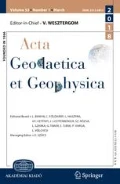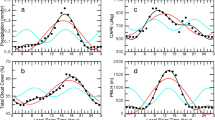Abstract
A new global mean energy budget diagram is offered for discussion and further examination. The main motivation for creating this figure was the observation that a quasi-discrete flux quantity structure seems to appear behind the best published energy budget data. This structure underneath the observed global energy flow system might represent an idealized, hypothetic normal (steady) state onto which the actual climatic regimes and their changes can be projected. The unit of the all-sky structure is the value of the flux element called longwave cloud radiative effect (LWCRE), termed also the greenhouse effect of clouds; under prevailing average conditions, it turns out to be numerically equal to the all-sky surface transmitted irradiance, ST(all). There is also a clear-sky structure, as reported in earlier studies, where the unit of measure is one ST(clear). Three important features are independent of the discrete units: (a) the energies at the surface are equal to the total energy at top-of-atmosphere plus one LWCRE; (b) the energies in the atmosphere are equal to the energy at the surface plus two LWCRE; (c) the shortwave (SW) radiation absorbed by the surface is equal to the longwave (LW) energy in the all-sky greenhouse effect. The aim of our study is to present the system as it reveals itself in the data; theoretical explanation is out of our recent scope.
Graphical Abstract


Similar content being viewed by others
Abbreviations
- ASR:
-
Absorbed (=incoming minus reflected) solar radiation
- β:
-
Cloud area fraction
- CERES:
-
Clouds and the Earth’s radiant energy system
- EBAF:
-
Energy balanced and filled
- f :
-
Transfer function, f = OLR/SU, also called planetary emissivity
- g :
-
Greenhouse function, g = G/SU = 1 − f
- G:
-
Greenhouse effect, G = SU − OLR
- GEWEX:
-
Global energy and water exchanges project
- ISCCP:
-
International satellite cloud climatology project
- LA :
-
Longwave radiation absorbed in the atmosphere
- LD :
-
Downward emitted atmospheric longwave radiation at the surface, also termed DLR or ‘back-radiation’
- LU :
-
Upward emitted atmospheric longwave radiation at TOA, also termed ‘thermal cooling to space’
- LH:
-
Latent heat (evapotranspiration)
- LWCRE:
-
Longwave cloud radiative effect
- NET:
-
Surface net longwave radiative cooling, NET = SU − LD(all)
- OLR:
-
Outgoing longwave radiation
- SA :
-
Shortwave radiation absorbed in the atmosphere
- SH:
-
Sensible heat (thermals, convection)
- SRF:
-
Surface
- ST :
-
Surface transmitted irradiance
- SU :
-
Surface upward longwave radiation
- TA :
-
Longwave transmittance, TA = ST/SU
- TOA:
-
Top of the atmosphere
References
Allan R (2006) Variability in clear-sky longwave radiative cooling of the atmosphere. J Geophys Res 111:D22105. doi:10.1029/2006JD007304
Allan R, Liu C, Loeb N, Palmer M, Roberts M, Smith D, Vidale P-L (2014) Changes in global net radiative imbalance 1985–2012. Geophys Res Lett 41(15):5588–5597. doi:10.1002/2014GL060962
Bengtsson L (2012) Foreword: International Space Science Institute (ISSI) workshop on observing and modeling earth’s energy flows. Surv Geophys 33:333–336. doi:10.1007/s10712-012-9194-y
Bengtsson L (2014) Foreword: International Space Science Institute (ISSI) workshop on the earth’s hydrological cycle. Surv Geophys 35:485–488. doi:10.1007/s10712-013-9265-8
Charlock TP, Ramanathan V (1985) The albedo field and cloud radiative forcing produced by a general circulation model with internally generated cloud optics. J Atmos Sci 42:1408–1429
Coakley JA, Baldwin DG (1984) Towards the objective analysis of clouds from satellite imagery data. J Clim Appl Meteorol 23:1065–1099
Costa S, Shine K (2012) Outgoing longwave radiation due to directly transmitted surface emission. J Atmos Sci 69:1865–1870. doi:10.1175/JAS-D-11-0248.1
Goody RM, Yung YL (1989) Atmospheric radiation: theoretical basis, 2nd edn. Oxford University Press, New York
Green JSA (1967) Division of radiative streams into internal transfer and cooling to space. Q J R Meteorol Soc 93:371–372
Hartmann DL, Tank AMGK, Rusticucci M, Alexander LV, Brönnimann S, Charabi Y, Dentener FJ, Dlugokencky EJ, Easterling DR, Kaplan A, Soden BJ, Thorne PW, Wild M, Zhai PM, IPCC (2013) Observations: atmosphere and surface. In: Stocker TF, Qin D, Plattner G-K, Tignor M, Allen SK, Boschung J, Nauels A, Xia Y, Bex V, Midgley PM (eds) Climate change 2013: the physical science basis. Contribution of Working Group I to the Fifth Assessment Report of the Intergovernmental Panel on Climate Change. Cambridge University Press, Cambridge
Inamdar A, Ramanathan V, Loeb N (2004) Satellite observations of the water vapor greenhouse effect and column longwave cooling rates. J Geophys Res 109:D06104. doi:10.1029/2003JD003980
Kiehl J, Trenberth K (1997) Earth’s annual global mean energy budget. Bull Am Meteorol Soc 78:197–208
L’Ecuyer T et al (2015) The observed state of the energy budget in the early 21st century. J Clim. doi:10.1175/JCLI-D-14-00556.1
Miskolczi F (2007) Greenhouse effect in semi-transparent planetary atmospheres. Idojaras Q J Hung Meteorol Serv 111:1-40. http://owww.met.hu/idojaras/IDOJARAS_vol111_No1_01.pdf
Miskolczi F, Mlynczak M (2004) The greenhouse effect and the spectral decomposition of the clear-sky terrestrial radiation. Idojaras Q J Hung Meteorol Serv 108:209-251. http://owww.met.hu/idojaras/IDOJARAS_vol108_No4_01.pdf
NASA (2014) NASA Langley Research Center energy budget poster, 26 June 2014 edition. http://science-edu.larc.nasa.gov/energy_budget/pdf/ERB_Litho_v2014.06.26.pdf
Ramanathan V (1987) The role of earth radiation budget studies in climate and general circulation research. J Geophys Res Atmos 92:4075–4095
Ramanathan V, Inamdar A (2006) The radiative forcing due to clouds and water vapor. In: Kiehl JT, Ramanathan V (eds) Frontiers of climate modeling. Cambridge University Press, Cambridge (chapter 5)
Ramanathan V, Cess RD, Harrison EF, Minnis P, Barkstrom BR, Ahmad E, Hartmann D (1989) Cloud radiative forcing and climate: results from the Earth Radiation Budget Experiment. Science 243:57–63
Raval A, Ramanathan V (1989) Observational determination of the greenhouse effect. Nature 342:758–761
Rossow W, Schiffer A (1999) Advances in understanding clouds from ISCCP. Bull Am Meteorol Soc 80:2261–2287
Stackhouse PW Jr, Gupta SK, Cox SJ, Zhang T, Mikovitz JC, Hinkelman LM (2011) The NASA/GEWEX surface radiation budget release 3.0, 24.5-year dataset. GEWEX News 21(1):10–12
Stephens G, Greenwald T (1991) The Earth’s radiation budget and its relation to atmospheric hydrology 2. Observation of cloud effects. J Geophys Res 96:15325–15340
Stephens G, L’Ecuyer T (2015) The Earth’s energy balance. J Atmos Res. doi:10.1016/j.atmosres.2015.06.024
Stephens GL, Slingo A, Webb M, Minnett P, Daum P, Kleinman L, Wittmeyer I, Randall D (1994) Observations of the Earth’s Radiation Budget in relation to atmospheric hydrology. Part IV: atmospheric column radiative cooling over the world’s oceans. J Geophys Res 99(D9):18585–18604
Stephens GL, Li J, Wild M, Clayson C, Loeb N, Kato S, L’Ecuyer T, Stackhouse W, Lebsock M, Andrews T (2012) An update on Earth’s energy balance in light of the latest observations. Nat Geosci 5:691–696. doi:10.1038/ngeo1580
Stevens B, Schwartz SE (2012) Observing and modeling Earth’s energy flows. Surv Geophys 33:779–816. doi:10.1007/s10712-012-9184-0
Stevens B et al. (2013) Atmospheric component of the MPI-M earth system model: ECHAM6. J Adv Model Earth Syst 5(2):146–172. doi:10.1002/jame.20015
Trenberth K, Fasullo J (2012) Tracking Earth’s energy: from El Nino to global warming. Surv Geophys 33:413–426. doi:10.1007/s10712-011-9150-2
Trenberth K, Fasullo J, Kiehl J (2009) Earth’s global energy budget. Bull Am Meteorol Soc 90:311–323
Wild M, Folini D, Schär C, Loeb N, Dutton E, König-Langlo G (2013) The global energy balance from a surface perspective. Clim Dyn 40:3107–3134. doi:10.1007/s00382-012-1569-8
Wild M, Folini D, Hakuba M, Schär C, Seneviratne S, Kato S, Rutan D, Ammann C, Wood E, König-Langlo G (2015) The energy balance over land and oceans: an assessment based on direct observations and CMIP5 climate models. Clim Dyn 44:3393–3429. doi:10.1007/s00382-014-2430-z
Acknowledgments
This work was partly supported by the Hungarian Academy of Sciences, contract No. 17/2010, 29.543/2010. The Geodetic and Geophysical Research Institute, Sopron, is highly appreciated for adopting this project.
Author information
Authors and Affiliations
Corresponding author
Rights and permissions
About this article
Cite this article
Zagoni, M. A new diagram of Earth’s global energy budget. Acta Geod Geophys 51, 481–492 (2016). https://doi.org/10.1007/s40328-015-0138-0
Received:
Accepted:
Published:
Issue Date:
DOI: https://doi.org/10.1007/s40328-015-0138-0




